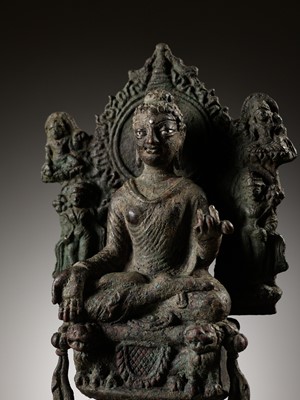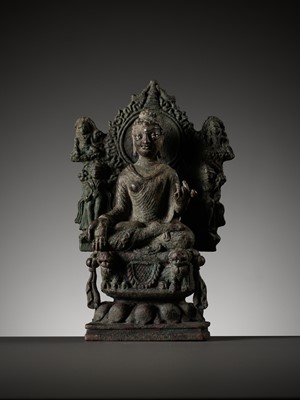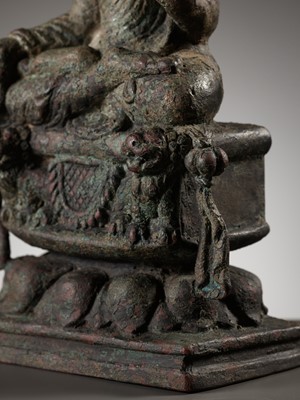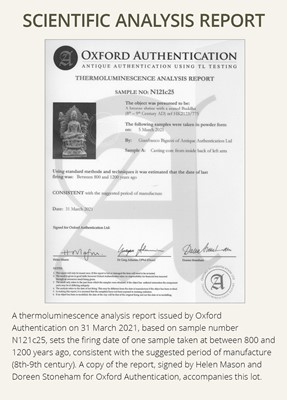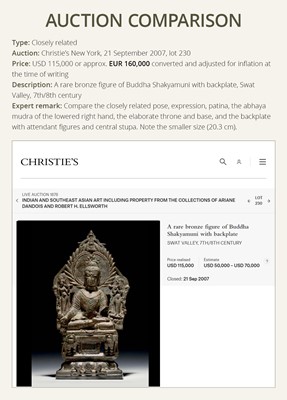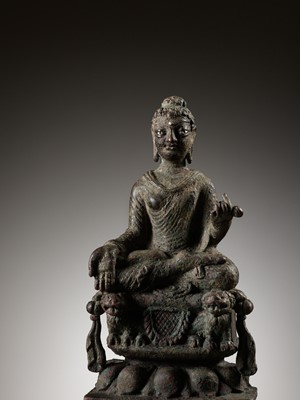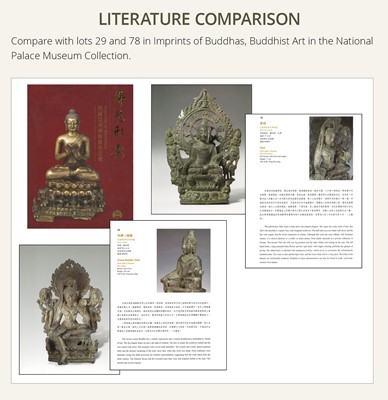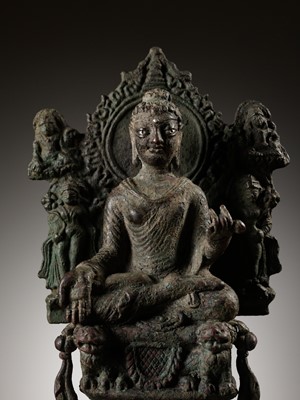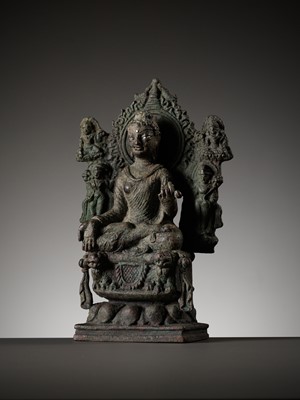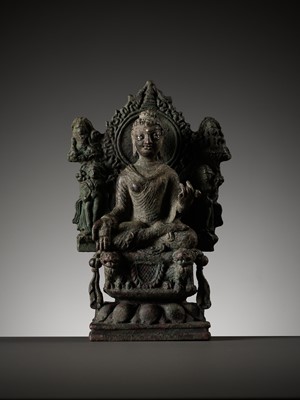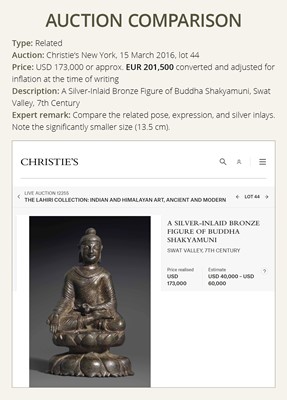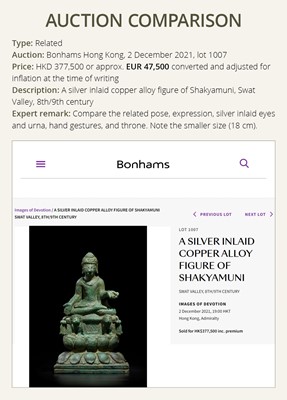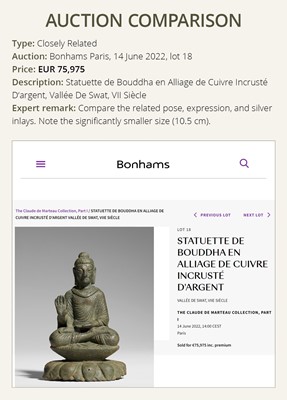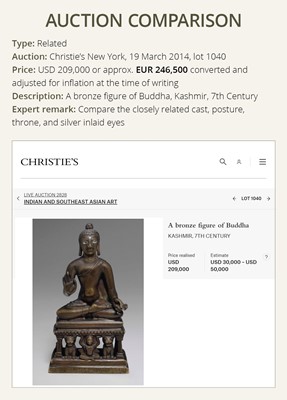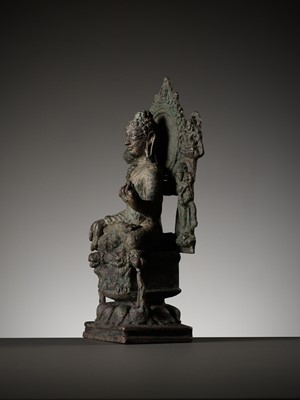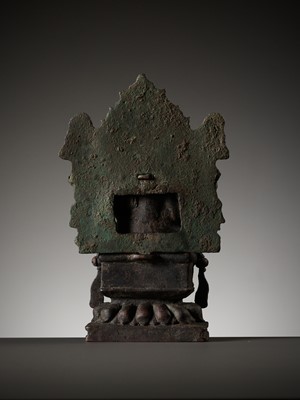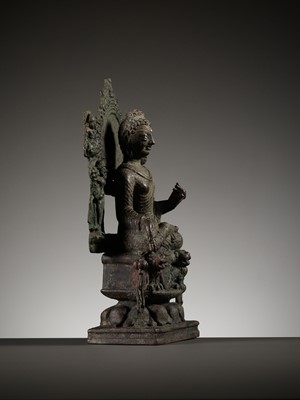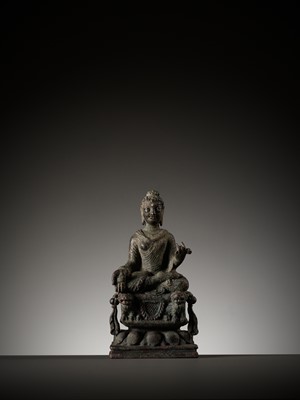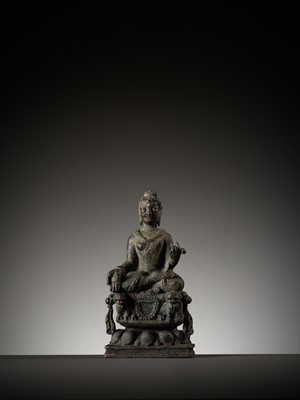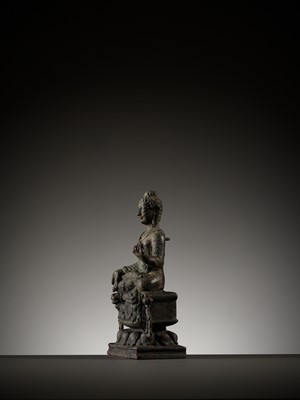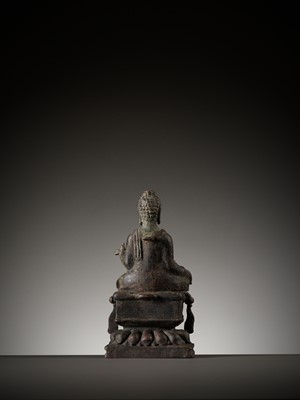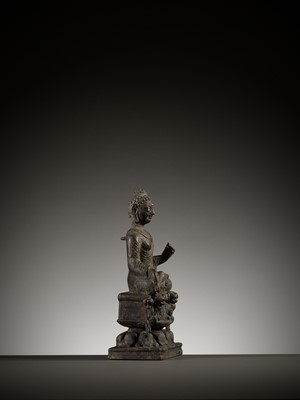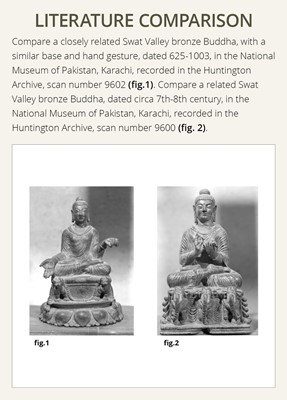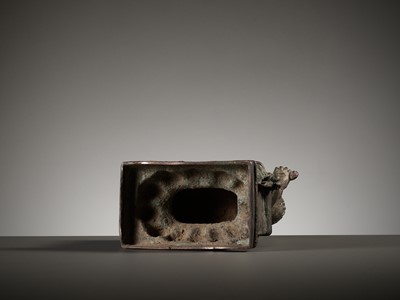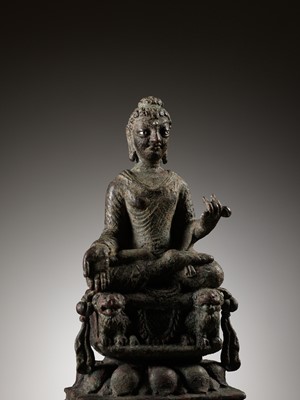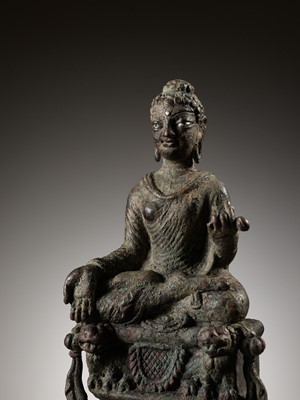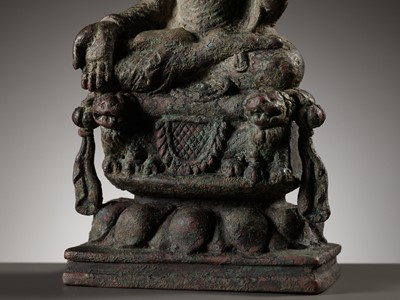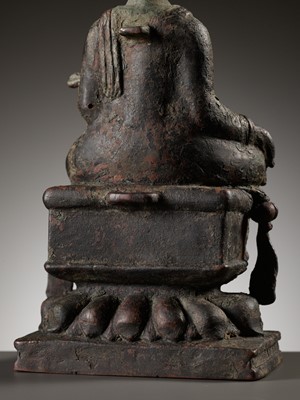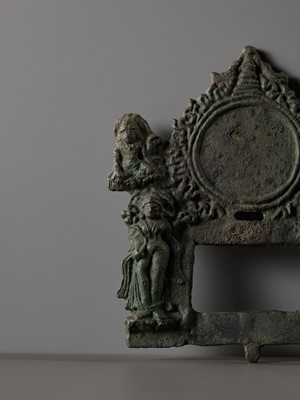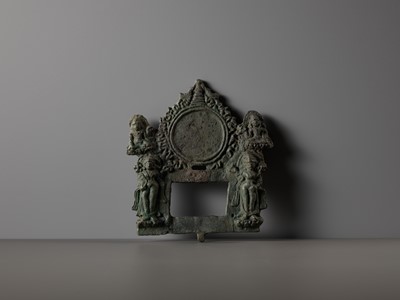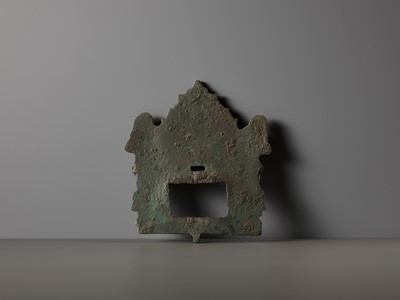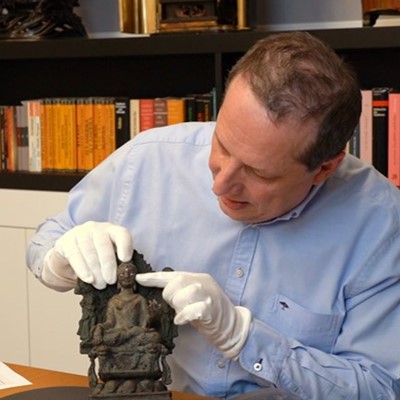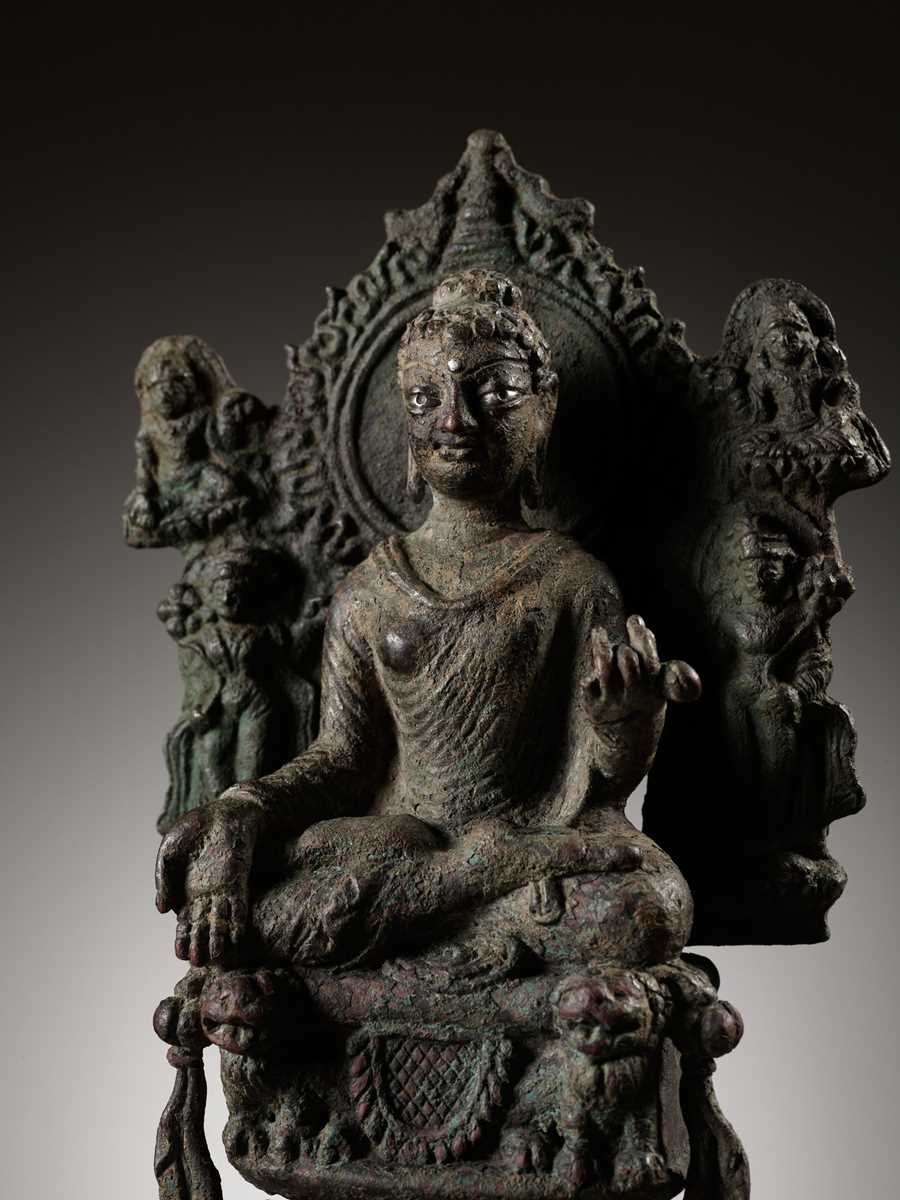9th Mar, 2023 13:00
TWO-DAY AUCTION - Fine Chinese Art / 中國藝術集珍 / Buddhism & Hinduism
233
A BRONZE FIGURE OF BUDDHA SHAKYAMUNI, SWAT VALLEY, 8TH-9TH CENTURY
八至九世紀斯瓦特谷釋迦牟尼銅像
Sold for €19,500
including Buyer's Premium
Scientific Analysis Report: A thermoluminescence analysis report issued by Oxford Authentication on 31 March 2021, based on sample number N121c25, sets the firing date of one sample taken at between 800 and 1200 years ago, consistent with the suggested period of manufacture (8th-9th century). A copy of the report, signed by Helen Mason and Doreen Stoneham for Oxford Authentication, accompanies this lot.
Seated on a cushion over an elaborate lotus throne with lions on either side and supported on a rectangular plinth, his right hand lowered in abhaya mudra and his left holding the hem of his sanghati falling over the chest in finely incised rhythmic folds. His serene face with silver-inlaid eyes and urna, deeply incised brows, and full lips forming a calm smile, flanked by long pendulous earlobes, the hair in tight curls over the ushnisha.
Provenance: A private collection in Hong Kong. German trade, acquired from the above.
Condition: Very good condition, commensurate with age. Extensive wear, some losses, obvious signs of weathering and erosion, soil encrustations, small nicks and dents, light scratches. Superb, naturally grown malachite and cuprite patina overall.
Weight: 1,894 g (incl. backplate) and 1,280 g (excl. backplate)
Dimensions: Height 25 cm (incl. backplate) and 22 cm (excl. backplate)
Few Swat bronzes are known that retain a complete backplate as in the present example. It is separately cast and inserted into a loop on the throne and a tang issuing from Buddha’s back. The flaming mandala is topped with a stupa and flanked by female bodhisattvas standing on lotus bases below seated male bodhisattvas.
According to Pal, placing Buddha on a throne like on the present lot associates him with royal imagery and emphasizes his spiritual sovereignty, while the lotus base symbolizes his divine quality (see Pal, Indian Sculpture, Vol.2, 1988, pp.68-9). His enlightened nature is further signaled by the silver-inlaid eyes and urna. Gently looking down with a compassionate expression, he extends his right hand in the gesture of charity. With his left, he holds the hem of his robe. The iconography of Shakyamuni holding his garment is widely employed in seated Swat figures, extending the idiom from earlier Gandharan stone images.
The Swat Valley is located along the upper stream of the Indus in the heartland of the Gandhara region. It was a melting pot of various people and arts and served as a link between India and Central Asia and further eastwards for a constant flow of Buddhist pilgrims. The earlier Gandhara style is still echoed in the art of many icons of the Swat Valley, as visible in the present example. The Buddha's parallel folds as well as the protuberance on top of his head, can be traced back to Gandhara Buddha figures. However, the V-shaped pleats around his neck are associated with Kashmiri prototypes, as is the use of silver inlay. His face reflects a Gupta idiom, with its small mouth and incised eyebrows. The lotus base on which he sits is typical for Swat Valley images. Thus, this fine bronze Buddha figure perfectly embodies the aforementioned melting pot of various styles.
Literature comparison:
Compare a closely related Swat Valley bronze Buddha, with a similar base and hand gesture, dated 625-1003, in the National Museum of Pakistan, Karachi, recorded in the Huntington Archive, scan number 9602. Compare a related Swat Valley bronze Buddha, dated circa 7th-8th century, in the National Museum of Pakistan, Karachi, recorded in the Huntington Archive, scan number 9600. Compare the throne, gestures, and the robe’s evenly arranged narrow folds with that of a closely related example published in von Schroeder, Buddhist Sculptures in Tibet, Vol. I, 2001, pp. 40-1, figs. 6A-C. Also see Pal, Bronzes of Kashmir, 1975, pp. 194-5, no. 73. For a fragment of a backplate from the Eilenberg Collection, see M. Lerner and S. Kossak, The Lotus Transcendent, 1991, cat. no. 86, p. 116. Furthermore, compare with lots 29 and 78 in Imprints of Buddhas, Buddhist Art in the National Palace Museum Collection.
Auction result comparison:
Type: Closely related
Auction: Christie’s New York, 21 September 2007, lot 230
Price: USD 115,000 or approx. EUR 160,000 converted and adjusted for inflation at the time of writing
Description: A rare bronze figure of Buddha Shakyamuni with backplate, Swat Valley, 7th/8th century
Expert remark: Compare the closely related pose, expression, patina, the abhaya mudra of the lowered right hand, the elaborate throne and base, and the backplate with attendant figures and central stupa. Note the smaller size (20.3 cm).
Auction result comparison:
Type: Related
Auction: Bonhams Hong Kong, 2 December 2021, lot 1007
Price: HKD 377,500 or approx. EUR 47,500 converted and adjusted for inflation at the time of writing
Description: A silver inlaid copper alloy figure of Shakyamuni, Swat Valley, 8th/9th century
Expert remark: Compare the related pose, expression, silver inlaid eyes and urna, hand gestures, and throne. Note the smaller size (18 cm).
Auction result comparison:
Type: Closely Related
Auction: Bonhams Paris, 14 June 2022, lot 18
Price: EUR 75,975
Description: Statuette de Bouddha en Alliage de Cuivre Incrusté D'argent, Vallée De Swat, VII Siècle
Expert remark: Compare the related pose, expression, and silver inlays. Note the significantly smaller size (10.5 cm).
Auction result comparison:
Type: Related
Auction: Christies New York, 15 March 2016, lot 44
Price: USD 173,000 or approx. EUR 201,500 converted and adjusted for inflation at the time of writing
Description: A Silver-Inlaid Bronze Figure of Buddha Shakyamuni, Swat Valley, 7th Century
Expert remark: Compare the related pose, expression, and silver inlays. Note the significantly smaller size (13.5 cm).
Auction result comparison:
Type: Related
Auction: Christie’s New York, 19 March 2014, lot 1040
Price: USD 209,000 or approx. EUR 246,500 converted and adjusted for inflation at the time of writing
Description: A bronze figure of Buddha, Kashmir, 7th Century
Expert remark: Compare the closely related cast, posture, throne, and silver inlaid eyes
八至九世紀斯瓦特谷釋迦牟尼銅像
釋迦牟尼坐在蓮座上,兩側各有一隻獅子,右手施觸地印,左手握住法衣下擺,胸前衣紋褶皺線條流暢。臉上鑲嵌著銀色的眼睛,雙眼之間有白毫,嘴唇豐滿,笑容安詳,長耳垂,頭頂螺髻。
科學檢測報告:隨附牛津檢測所2021年3月31日由Doreen Stoneham出具的熱釋光檢測報告複印本,樣本號N121c25,結果為該造像為800至1200年前製作,符合推測的八至九世紀。
來源:香港私人收藏;德國收藏購於上述收藏。
品相:狀態極好,大量磨損,一些缺損,明顯的風化和侵蝕跡象,土壤結垢,小刻痕和凹痕,輕微劃痕。包漿自然。
重量:1,894 g (含光背),1,280克 (不含光背)
尺寸:高 25 厘米 (含光背),22 厘米 (不含光背)
很少斯瓦特青銅造像有本例那樣保留完整的光背,頂部有一座佛塔,兩側是站在蓮座上的女菩薩,下方是坐著的男菩薩。
根據 Pal 的說法,將佛陀放在現在這樣的蓮座上,將他與皇家形象聯繫起來,並強調他的精神主權,而蓮花底座象徵著他的神聖品質(見 Pal,Indian Sculpture,卷2,1988年,68- 9頁)。鑲銀的眼睛和白毫進一步表明了他開明的本性。慈悲的表情,伸出右手,做出施捨的姿態,他的左手抓住長袍的下擺。釋迦牟尼拿著他的衣服的圖像被廣泛應用於坐著的斯瓦特人物,是從早期的犍陀羅石像中延伸出來的。
斯瓦特河谷位於犍陀羅地區中心地帶的印度河上游。 它是各種人文和藝術的聚居地,是連接印度和中亞以及更遠的東方朝聖者的紐帶。早期的犍陀羅風格仍然在斯瓦特山谷的許多造像藝術中得到呼應。佛像的平行褶皺以及頭頂的螺髻,都可以追溯到犍陀羅佛像。 然而,他脖子上的 V 形褶皺與銀鑲嵌的使用與克什米爾原型有關。他的臉像古普塔人,小嘴和尖銳的眉毛。他所坐的蓮花底座是斯瓦特山谷圖像的典型代表。
文獻比較:
比較一件非常相近的公元625-1003年斯瓦特谷佛像,有相似的底座和手勢,收藏於喀拉蚩National Museum of Pakistan,紀錄於Huntington Archive,編號9602。比較一件相近的公元七至八世紀斯瓦特谷佛像,收藏於喀拉蚩National Museum of Pakistan,紀錄於Huntington Archive,編號9600。比較底座、手勢和長袍,出版於 von Schroeder,《Buddhist Sculptures in Tibet》,卷I,2001,頁40-1,圖6A-C。見 Pal,《Bronzes of Kashmir》,1975年,頁194-5,編號73。關於一片背板收藏於Eilenberg Collection,見M. Lerner and S. Kossak,《The Lotus Transcendent》,1991年,圖錄編號86,頁116。比較故宮博物院藏佛教藝術品《Imprints of Buddhas》,圖錄編號29和78。
拍賣結果比較:
形制:非常相近
拍賣:紐約佳士得, 2007年9月21日,lot 230
價格:USD 115,000(相當於今日EUR 160,000)
描述:七至八世紀斯瓦特谷釋迦牟尼銅像
專家評論:比較非常相近的姿勢、表情、包漿、右手觸地印、椅背和底座,以及背板旁的侍從和中央的佛塔。請注意尺寸較小(20.3 厘米)。
拍賣結果比較:
形制:相近
拍賣:香港邦瀚斯,2021年12月2日,lot 1007
價格:HKD 377,500(相當於今日EUR 47,500)
描述:斯瓦特八/九世紀銅錯銀釋迦牟尼像
專家評論:比較相近的姿勢、表情、銀鑲嵌雙眼和白毫、手勢和王座。請注意尺寸較小(18 厘米)。
拍賣結果比較:
形制:非常相近
拍賣:巴黎邦瀚斯,2022年6月14日,lot 18
價格:EUR 75,975
描述:斯瓦特七世紀銅錯銀佛陀像
專家評論:比較相近的姿勢、表情、銀鑲嵌。請注意尺寸明顯較小(10.5 厘米)。
拍賣結果比較:
形制:相近
拍賣:紐約佳士得,2016年3月15日,lot 44
價格:USD 173,000(相當於今日EUR 201,500)
描述:七世紀斯瓦特谷錯銀釋迦牟尼銅像
專家評論:比較相近的姿勢、表情、銀鑲嵌。請注意尺寸明顯較小(13.5 厘米)。
拍賣結果比較:
形制:相近
拍賣:紐約佳士得,2014年3月19日,lot 1040
價格:USD 209,000(相當於今日EUR 246,500)
描述:七世紀喀什米爾佛銅像
專家評論:比較非常相近的鑄造、手勢、王座和銀鑲嵌雙眼。
Scientific Analysis Report: A thermoluminescence analysis report issued by Oxford Authentication on 31 March 2021, based on sample number N121c25, sets the firing date of one sample taken at between 800 and 1200 years ago, consistent with the suggested period of manufacture (8th-9th century). A copy of the report, signed by Helen Mason and Doreen Stoneham for Oxford Authentication, accompanies this lot.
Seated on a cushion over an elaborate lotus throne with lions on either side and supported on a rectangular plinth, his right hand lowered in abhaya mudra and his left holding the hem of his sanghati falling over the chest in finely incised rhythmic folds. His serene face with silver-inlaid eyes and urna, deeply incised brows, and full lips forming a calm smile, flanked by long pendulous earlobes, the hair in tight curls over the ushnisha.
Provenance: A private collection in Hong Kong. German trade, acquired from the above.
Condition: Very good condition, commensurate with age. Extensive wear, some losses, obvious signs of weathering and erosion, soil encrustations, small nicks and dents, light scratches. Superb, naturally grown malachite and cuprite patina overall.
Weight: 1,894 g (incl. backplate) and 1,280 g (excl. backplate)
Dimensions: Height 25 cm (incl. backplate) and 22 cm (excl. backplate)
Few Swat bronzes are known that retain a complete backplate as in the present example. It is separately cast and inserted into a loop on the throne and a tang issuing from Buddha’s back. The flaming mandala is topped with a stupa and flanked by female bodhisattvas standing on lotus bases below seated male bodhisattvas.
According to Pal, placing Buddha on a throne like on the present lot associates him with royal imagery and emphasizes his spiritual sovereignty, while the lotus base symbolizes his divine quality (see Pal, Indian Sculpture, Vol.2, 1988, pp.68-9). His enlightened nature is further signaled by the silver-inlaid eyes and urna. Gently looking down with a compassionate expression, he extends his right hand in the gesture of charity. With his left, he holds the hem of his robe. The iconography of Shakyamuni holding his garment is widely employed in seated Swat figures, extending the idiom from earlier Gandharan stone images.
The Swat Valley is located along the upper stream of the Indus in the heartland of the Gandhara region. It was a melting pot of various people and arts and served as a link between India and Central Asia and further eastwards for a constant flow of Buddhist pilgrims. The earlier Gandhara style is still echoed in the art of many icons of the Swat Valley, as visible in the present example. The Buddha's parallel folds as well as the protuberance on top of his head, can be traced back to Gandhara Buddha figures. However, the V-shaped pleats around his neck are associated with Kashmiri prototypes, as is the use of silver inlay. His face reflects a Gupta idiom, with its small mouth and incised eyebrows. The lotus base on which he sits is typical for Swat Valley images. Thus, this fine bronze Buddha figure perfectly embodies the aforementioned melting pot of various styles.
Literature comparison:
Compare a closely related Swat Valley bronze Buddha, with a similar base and hand gesture, dated 625-1003, in the National Museum of Pakistan, Karachi, recorded in the Huntington Archive, scan number 9602. Compare a related Swat Valley bronze Buddha, dated circa 7th-8th century, in the National Museum of Pakistan, Karachi, recorded in the Huntington Archive, scan number 9600. Compare the throne, gestures, and the robe’s evenly arranged narrow folds with that of a closely related example published in von Schroeder, Buddhist Sculptures in Tibet, Vol. I, 2001, pp. 40-1, figs. 6A-C. Also see Pal, Bronzes of Kashmir, 1975, pp. 194-5, no. 73. For a fragment of a backplate from the Eilenberg Collection, see M. Lerner and S. Kossak, The Lotus Transcendent, 1991, cat. no. 86, p. 116. Furthermore, compare with lots 29 and 78 in Imprints of Buddhas, Buddhist Art in the National Palace Museum Collection.
Auction result comparison:
Type: Closely related
Auction: Christie’s New York, 21 September 2007, lot 230
Price: USD 115,000 or approx. EUR 160,000 converted and adjusted for inflation at the time of writing
Description: A rare bronze figure of Buddha Shakyamuni with backplate, Swat Valley, 7th/8th century
Expert remark: Compare the closely related pose, expression, patina, the abhaya mudra of the lowered right hand, the elaborate throne and base, and the backplate with attendant figures and central stupa. Note the smaller size (20.3 cm).
Auction result comparison:
Type: Related
Auction: Bonhams Hong Kong, 2 December 2021, lot 1007
Price: HKD 377,500 or approx. EUR 47,500 converted and adjusted for inflation at the time of writing
Description: A silver inlaid copper alloy figure of Shakyamuni, Swat Valley, 8th/9th century
Expert remark: Compare the related pose, expression, silver inlaid eyes and urna, hand gestures, and throne. Note the smaller size (18 cm).
Auction result comparison:
Type: Closely Related
Auction: Bonhams Paris, 14 June 2022, lot 18
Price: EUR 75,975
Description: Statuette de Bouddha en Alliage de Cuivre Incrusté D'argent, Vallée De Swat, VII Siècle
Expert remark: Compare the related pose, expression, and silver inlays. Note the significantly smaller size (10.5 cm).
Auction result comparison:
Type: Related
Auction: Christies New York, 15 March 2016, lot 44
Price: USD 173,000 or approx. EUR 201,500 converted and adjusted for inflation at the time of writing
Description: A Silver-Inlaid Bronze Figure of Buddha Shakyamuni, Swat Valley, 7th Century
Expert remark: Compare the related pose, expression, and silver inlays. Note the significantly smaller size (13.5 cm).
Auction result comparison:
Type: Related
Auction: Christie’s New York, 19 March 2014, lot 1040
Price: USD 209,000 or approx. EUR 246,500 converted and adjusted for inflation at the time of writing
Description: A bronze figure of Buddha, Kashmir, 7th Century
Expert remark: Compare the closely related cast, posture, throne, and silver inlaid eyes
八至九世紀斯瓦特谷釋迦牟尼銅像
釋迦牟尼坐在蓮座上,兩側各有一隻獅子,右手施觸地印,左手握住法衣下擺,胸前衣紋褶皺線條流暢。臉上鑲嵌著銀色的眼睛,雙眼之間有白毫,嘴唇豐滿,笑容安詳,長耳垂,頭頂螺髻。
科學檢測報告:隨附牛津檢測所2021年3月31日由Doreen Stoneham出具的熱釋光檢測報告複印本,樣本號N121c25,結果為該造像為800至1200年前製作,符合推測的八至九世紀。
來源:香港私人收藏;德國收藏購於上述收藏。
品相:狀態極好,大量磨損,一些缺損,明顯的風化和侵蝕跡象,土壤結垢,小刻痕和凹痕,輕微劃痕。包漿自然。
重量:1,894 g (含光背),1,280克 (不含光背)
尺寸:高 25 厘米 (含光背),22 厘米 (不含光背)
很少斯瓦特青銅造像有本例那樣保留完整的光背,頂部有一座佛塔,兩側是站在蓮座上的女菩薩,下方是坐著的男菩薩。
根據 Pal 的說法,將佛陀放在現在這樣的蓮座上,將他與皇家形象聯繫起來,並強調他的精神主權,而蓮花底座象徵著他的神聖品質(見 Pal,Indian Sculpture,卷2,1988年,68- 9頁)。鑲銀的眼睛和白毫進一步表明了他開明的本性。慈悲的表情,伸出右手,做出施捨的姿態,他的左手抓住長袍的下擺。釋迦牟尼拿著他的衣服的圖像被廣泛應用於坐著的斯瓦特人物,是從早期的犍陀羅石像中延伸出來的。
斯瓦特河谷位於犍陀羅地區中心地帶的印度河上游。 它是各種人文和藝術的聚居地,是連接印度和中亞以及更遠的東方朝聖者的紐帶。早期的犍陀羅風格仍然在斯瓦特山谷的許多造像藝術中得到呼應。佛像的平行褶皺以及頭頂的螺髻,都可以追溯到犍陀羅佛像。 然而,他脖子上的 V 形褶皺與銀鑲嵌的使用與克什米爾原型有關。他的臉像古普塔人,小嘴和尖銳的眉毛。他所坐的蓮花底座是斯瓦特山谷圖像的典型代表。
文獻比較:
比較一件非常相近的公元625-1003年斯瓦特谷佛像,有相似的底座和手勢,收藏於喀拉蚩National Museum of Pakistan,紀錄於Huntington Archive,編號9602。比較一件相近的公元七至八世紀斯瓦特谷佛像,收藏於喀拉蚩National Museum of Pakistan,紀錄於Huntington Archive,編號9600。比較底座、手勢和長袍,出版於 von Schroeder,《Buddhist Sculptures in Tibet》,卷I,2001,頁40-1,圖6A-C。見 Pal,《Bronzes of Kashmir》,1975年,頁194-5,編號73。關於一片背板收藏於Eilenberg Collection,見M. Lerner and S. Kossak,《The Lotus Transcendent》,1991年,圖錄編號86,頁116。比較故宮博物院藏佛教藝術品《Imprints of Buddhas》,圖錄編號29和78。
拍賣結果比較:
形制:非常相近
拍賣:紐約佳士得, 2007年9月21日,lot 230
價格:USD 115,000(相當於今日EUR 160,000)
描述:七至八世紀斯瓦特谷釋迦牟尼銅像
專家評論:比較非常相近的姿勢、表情、包漿、右手觸地印、椅背和底座,以及背板旁的侍從和中央的佛塔。請注意尺寸較小(20.3 厘米)。
拍賣結果比較:
形制:相近
拍賣:香港邦瀚斯,2021年12月2日,lot 1007
價格:HKD 377,500(相當於今日EUR 47,500)
描述:斯瓦特八/九世紀銅錯銀釋迦牟尼像
專家評論:比較相近的姿勢、表情、銀鑲嵌雙眼和白毫、手勢和王座。請注意尺寸較小(18 厘米)。
拍賣結果比較:
形制:非常相近
拍賣:巴黎邦瀚斯,2022年6月14日,lot 18
價格:EUR 75,975
描述:斯瓦特七世紀銅錯銀佛陀像
專家評論:比較相近的姿勢、表情、銀鑲嵌。請注意尺寸明顯較小(10.5 厘米)。
拍賣結果比較:
形制:相近
拍賣:紐約佳士得,2016年3月15日,lot 44
價格:USD 173,000(相當於今日EUR 201,500)
描述:七世紀斯瓦特谷錯銀釋迦牟尼銅像
專家評論:比較相近的姿勢、表情、銀鑲嵌。請注意尺寸明顯較小(13.5 厘米)。
拍賣結果比較:
形制:相近
拍賣:紐約佳士得,2014年3月19日,lot 1040
價格:USD 209,000(相當於今日EUR 246,500)
描述:七世紀喀什米爾佛銅像
專家評論:比較非常相近的鑄造、手勢、王座和銀鑲嵌雙眼。
Zacke Live Online Bidding
Our online bidding platform makes it easier than ever to bid in our auctions! When you bid through our website, you can take advantage of our premium buyer's terms without incurring any additional online bidding surcharges.
To bid live online, you'll need to create an online account. Once your account is created and your identity is verified, you can register to bid in an auction up to 12 hours before the auction begins.
Intended Spend and Bid Limits
When you register to bid in an online auction, you will need to share your intended maximum spending budget for the auction. We will then review your intended spend and set a bid limit for you. Once you have pre-registered for a live online auction, you can see your intended spend and bid limit by going to 'Account Settings' and clicking on 'Live Bidding Registrations'.
Your bid limit will be the maximum amount you can bid during the auction. Your bid limit is for the hammer price and is not affected by the buyer’s premium and VAT. For example, if you have a bid limit of €1,000 and place two winning bids for €300 and €200, then you will only be able to bid €500 for the rest of the auction. If you try to place a bid that is higher than €500, you will not be able to do so.
Online Absentee and Telephone Bids
You can now leave absentee and telephone bids on our website!
Absentee Bidding
Once you've created an account and your identity is verified, you can leave your absentee bid directly on the lot page. We will contact you when your bids have been confirmed.
Telephone Bidding
Once you've created an account and your identity is verified, you can leave telephone bids online. We will contact you when your bids have been confirmed.
Classic Absentee and Telephone Bidding Form
You can still submit absentee and telephone bids by email or fax if you prefer. Simply fill out the Absentee Bidding/Telephone bidding form and return it to us by email at office@zacke.at or by fax at +43 (1) 532 04 52 20. You can download the PDF from our Upcoming Auctions page.
How-To Guides
How to Create Your Personal Zacke Account
How to Register to Bid on Zacke Live
How to Leave Absentee Bids Online
How to Leave Telephone Bids Online
中文版本的操作指南
创建新账号
注册Zacke Live在线直播竞拍(免平台费)
缺席投标和电话投标
Third-Party Bidding
We partner with best-in-class third-party partners to make it easy for you to bid online in the channel of your choice. Please note that if you bid with one of our third-party online partners, then there will be a live bidding surcharge on top of your final purchase price. You can find all of our fees here. Here's a full list of our third-party partners:
- 51 Bid Live
- EpaiLive
- ArtFoxLive
- Invaluable
- LiveAuctioneers
- the-saleroom
- lot-tissimo
- Drouot
Please note that we place different auctions on different platforms. For example, in general, we only place Chinese art auctions on 51 Bid Live.
Bidding in Person
You must register to bid in person and will be assigned a paddle at the auction. Please contact us at office@zacke.at or +43 (1) 532 04 52 for the latest local health and safety guidelines.
